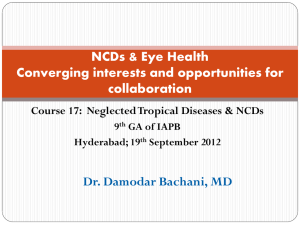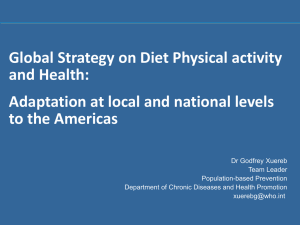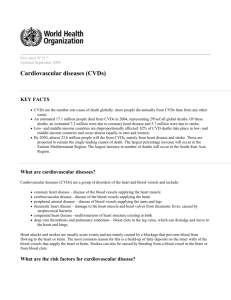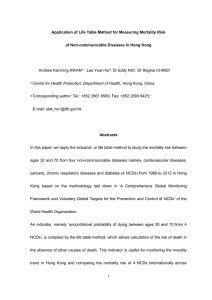CHRONIC diseases
advertisement
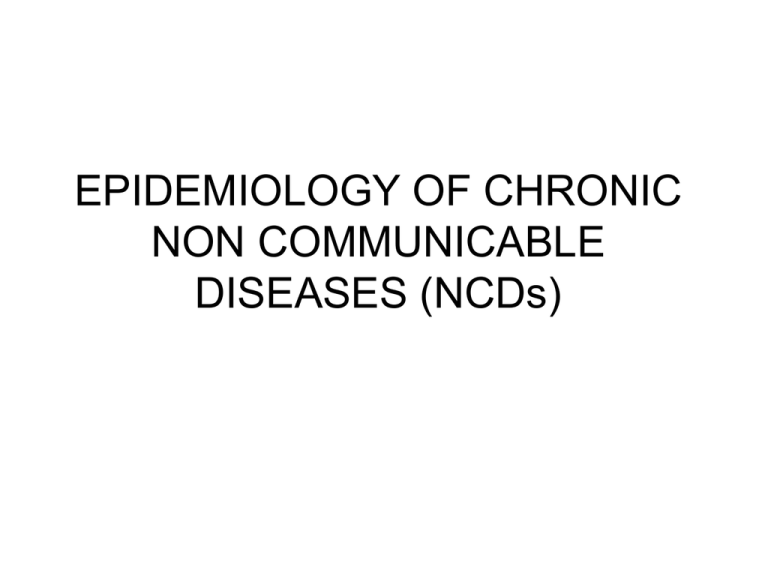
EPIDEMIOLOGY OF CHRONIC NON COMMUNICABLE DISEASES (NCDs) CHRONIC DISEASE All impairments or deviations from normal which have one or more of the following characteristics : • • • • Permanent Leave residual disability Caused by a non-reversible pathology Required special training of the patient for rehabilitation • Required long period of supervision, observation or care Problems in etiologic investigation of Chronic Non-Communicable Diseases (NCDs): 1.Absence of a known agent 2.Multifactor nature of etiology 3.Long latent period 4.Indefinite onset 5.Differential effect of factors on incidence and course of Prevention of NCDs received little attention by policy makers, medical professionals, and general public because: • The extent is less sufficiently examined • Long delay between cause and effect PRIMARY Prevention is possible for most NCDs due to the following facts: 1.Large population differences in incidence and mortality of NCDs 2.Dynamic national trends in incidence and mortality rates of most NCDs 3.Rapid changes in risk of many NCDs among migrant population 4,Positive results of intervention trials 5.Identification of modifiable risk factors of many NCDs EPIDEMIOLOGIC TRANSITION It is the general shift from acute infectious and nutritional deficiency diseases characteristic of under development to chronic NCDs characteristic of modernization and advanced level of development. 1. Demographic Changes • Decrease in infant mortality rate • Decrease in fertility rate Both lead to Population aging 2. Urbanization and Socioeconomic Transformation • • • • • • Changes in community relationships Changes in life style Decreased concerns about moral beliefs Human mobility Expansion of education Participation of women in labor force 3. Changes in Nutritional pattern • Rapid increase in food energy availability and consumption • Percapita food energy and protein availability had increased by 2 folds Availability of: rice increased by 5 folds wheat increased by 8 folds sugar increased by 3 folds fat increased by 3 folds No increase in vegetables Slight increase in fruits • Obesity is emerging as a major public health problem 4. Others: • Smoking epidemic • Increase in alcohol consumption • Sedentary life style EPIDEMIOLOGY OF ARDIOVASCULAR DISEASES (CVDs) • Worldwide CVDs are responsible for 1/4th of all deaths • In developed countries they are responsible for 50% of all deaths • In developed countries they are responsible for 23% of all deaths • Numerically speaking, developing countries are experiencing more deaths due to CVDs than developed countries. In 1990, worldwide about 50 million deaths had occurred • CVD • Resp.Dis LRTI COPD TB CA-Lung Asthma+ URTI 29% First leading cause 19% second leading cause 8.5% 4% 4% 2% 0.4% Developed Developing ----------------------------------------------50 million deaths 11 million 39 million • • • • • • CVDs Resp.Dis. Lung Cancer COPD LRTI TB 49%( 5,390,000) 12% 5% 3% 3% 0.25% 23 %(8,070,000) 23% 1% 4% 10% 5% • In EMR including Iraq, the magnitude of morbidity, mortality, disability, human suffering and economic cost are huge. • Demographic, socioeconomic and behavioral transformation (urbanization, emergence of modern lifestyle, and progressive aging) had led to increase CVDs problem. • The epidemic of CVDs began in developed countries in the 1st half of the 20th century; reaching the peak in 1960s, then started to decline. In developing countries the curve is still rising. • Inter and within country variation in incidence and mortality from CVDs are correlated with variation of major risk factors of CVDs.

